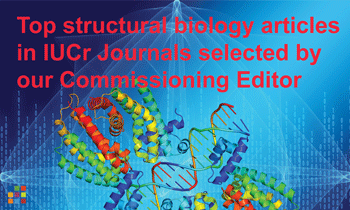issue contents
April 2022 issue

Cover illustration: Ribbon diagram and surface representation of two perpendicular views of the D-alanyl carrier protein ligase DltA from Staphylococcus aureus Mu50 with an ATP molecule bound in the active site [Lee et al. (2022), Acta Cryst. D78, 424–434]. The D-alanylation pathway has emerged as a promising antibacterial target against drug-resistant S. aureus and DltA is the first protein in this pathway.
CCP-EM
Open  access
access
 access
accessNew computational biophysics pipelines for analysing the global dynamics of structural ensembles and large, dynamic complexes resolved by cryoEM are reviewed.
Open  access
access
 access
accessSingle-particle analysis (SPA) by cryo-electron microscopy comprises the estimation of many parameters along its image-processing pipeline. Overfitting observed in SPA is normally due to misestimated parameters, and the only way to identify these is by comparing the estimates of multiple algorithms or, at least, multiple executions of the same algorithm.
research papers
Open  access
access
 access
accessThe crystal structure and functional characterization of DltA from Staphylococcus aureus, a D-alanyl carrier protein ligase that is the first protein in the D-alanylation pathway, are reported.
PDB reference: D-alanine alanyl carrier protein ligase, 7vhv
Open  access
access
 access
accessThe structure of the monomodular Pseudomonas aeruginosa bacteriophage JG004 lysin Pae87 is presented and investigated in relation to repurposing its function as an antimicrobial agent. The structure with its peptidoglycan ligand revealed a possible cell-wall-binding region. A C-terminal antimicrobial peptide-like region is shown to be important for disrupting the bacterial cell wall.
Open  access
access
 access
accessNew restraint dictionaries for carbohydrates in the pyranose form have been produced using the latest methods as released in CCP4. The new restraints allow users to keep pyranoside models in their lowest energy conformation during refinement.
Open  access
access
 access
accessCSSR, an algorithm for assigning secondary structures to RNA 3D structures with missing atoms, has been developed. The base-pair assignment accuracy is close to 90% for 3D structures in which only one atom per nucleotide can be empirically identified.
Open  access
access
 access
accessCrystal structures of bisphosphoglycerate mutase (BPGM) with 2-phosphoglycolate in the presence and absence of 2,3-bisphosphoglycerate are reported. The structures identified a novel binding site for 2-phosphoglycolate at the dimer interface of BPGM, as well as showing a snapshot of the catalytic activity of BPGM.
Open  access
access
 access
accessA framework is presented for refining models from several data frames from the same size-exclusion chromatography small-angle scattering experiment. The method can be employed to drastically reduce the number of parameters refined from the data series.
Open  access
access
 access
accessThe first crystal structure of the putative cell-wall biosynthesis protein LmcA from Mycobacterium smegmatis is reported at 1.8 Å resolution. The structure revealed an elongated β-barrel fold enclosing two distinct cavities, indicating a possible lipid-binding function in lipomannan/lipoarabinomannan biosynthesis.
This article describes a new strategy for the rapid crystallization of PDZ domains using annexin A2 as a crystallization chaperone.
PDB references: second PDZ domain of DLG1 complexed with the PDZ-binding motif of HTLV1-TAX1, 7pc3; PDZ domain of SNTB1 complexed with the PDZ-binding motif of HTLV1-TAX1, 7pc4; third PDZ domain of PDZD7 complexed with the PDZ-binding motif of EXOC4, 7pc5; PDZ domain of SNTG1 complexed with the acetylated PDZ-binding motif of PTEN, 7pc7; PDZ domain of SNTG1 complexed with the phosphomimetic mutant PDZ-binding motif, 7pc8; PDZ domain of SYNJ2BP complexed with the PDZ-binding motif of HTLV1-TAX1, 7pc9; PDZ domain of SNX27 fused with ANXA2, 7pcb; PDZ domain of SNTG2 complexed with the phosphorylated PDZ-binding motif of RSK1, 7qql; PDZ domain of LRRC7 fused with ANXA2, 7qqm; PDZ domain of SNTG1 complexed with the acetylated PDZ-binding motif of TRPV3, 7qqn
The new artificial intelligence-based protein structure modeling programs such as AlphaFold and RoseTTAFold have raised great enthusiasm in the scientific community. Here, it is shown that the excellent overall quality of these models can solve the phase problem faced by structural biology using X-ray diffraction. This study also validates these in silico models.
PDB reference: Kluyveromyces lactis Nmd4, 7qhy
The uncharacterized protein TW9814 was identified to be a phosphodiesterase (PDE) that is active towards bis(p-nitrophenyl)phosphate in the presence of manganese(II) or nickel(II). TW9814 has a unique metal coordination and shows remarkable catalytic efficiency compared with other PDEs.
PDB reference: TW9814, 7dck

 journal menu
journal menu






























